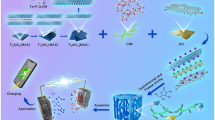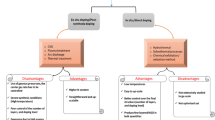Abstract
A new synthesis route based on polycondensation of phenol and formaldehyde cross-linked by graphene oxide (GO) was developed. Wet gel after gelation was converted into an organic xerogel by ambient pressure drying to obtain GO-cross-linked phenol–formaldehyde (PF) organic xerogels (GOCPFOX). Graphene-cross-linked PF carbon xerogels (GCPFCX) were produced by carbonization. The morphology and chemical structure of GOCPFOX and GCPFCX were analyzed. The electrochemical behavior of GCPFCX as an electrode material in electric double-layer capacitors (EDLCs) was investigated. Results show that the high mechanical strength of GO increased the gel skeleton strength; thus, organic xerogels exhibit very low drying shrinkage. Scanning electron micrographs indicated that addition of GO altered the gel structure. Thus, when GO was added into the PF solution, the PF molecular chains were anchored on the surface of GO by chemical and physical interaction. The GCPFCX-10 sample achieved the highest specific surface area, mesoporous volume, and specific capacity with 378 m2/g, 0.56 cm3/g, and 116 F/g, respectively. Hence, GCPFCX is a potential material for EDLCs owing to its low production cost and ability to avoid supercritical drying.









Similar content being viewed by others
References
Pekala RW, Alviso CT, Kong FM, Hulsley SS (1992) Aerogels derived from multifunctional organic monomers. J Non-Cryst Solids 145:90–98
Pekala RW (1989) Organic aerogels from the polycondensation of resorcinol with formaldehyde. J Mater Sci 24:3221–3227
Yamamoto T, Endo A, Ohmori T, Nakaiwa M (2004) Porous properties of carbon gel microspheres for gas separation. Carbon 42:1671–1676
Moreno-Castilla C, Maldonado-Hódar FJ (2005) Carbon aerogels for catalysis applications: an overview. Carbon 43:455–465
Kim SJ, Hwang SW, Hyun SH (2005) Preparation of carbon aerogel electrodes for supercapacitor and their electrochemical characteristics. J Mater Sci 40:725–731
Frackowiak E, Beguin F (2001) Carbon materials for the electrochemical storage of energy in capacitors. Carbon 39:937–950
Zhu Y, Hu H, Li W, Zhang X (2006) Cresol-formaldehyde based carbon aerogel as electrode material for electrochemical capacitor. J Power Sources 162:738–742
Li W, Guo S (2000) Preparation of low-density carbon aerogels from a cresol/formaldehyde mixture. Carbon 38:1520–1523
Li W, Lu A, Guo S (2001) Characterization of the microstructures of organic and carbon aerogels based upon mixed cresol–formaldehyde. Carbon 39:1989–1994
Li W, Reichenauer G, Fricke J (2002) Carbon aerogels derived from cresol–resorcinol–formaldehyde for supercapacitors. Carbon 40:2955–2959
Li W, Lu A, Guo S (2002) Control of mesoporous structure of aerogels derived from cresol–formaldehyde. J Colloid Interface Sci 254:153–157
Mukai SR, Tamitsuji C, Nishihara H, Tamon H (2005) Preparation of mesoporous carbon gels from an inexpensive combination of phenol and formaldehyde. Carbon 43:2628–2630
Wu D, Fu R, Sun Z, Yu Z (2005) Low-density organic and carbon aerogels from the sol-gel polymerization of phenol with formaldehyde. J Non-Cryst Solids 351:915–921
Jirglová H, Pérez-Cadenas AF, Maldonado-Hódar FJ (2009) Synthesis and properties of phloroglucinol–phenol–formaldehyde carbon aerogels and xerogels. Langmuir 25:2461–2466
Scherdel C, Gayer R, Slawik T, Reichenauer G, Scherb T (2011) Organic and carbon xerogels derived from sodium carbonate controlled polymerization of aqueous phenol–formaldehyde solutions. J Porous Mater 18:443–450
Scherdel C, Gayer R, Reichenauer G (2011) Porous organic and carbon xerogels derived from alkaline aqueous phenol–formaldehyde solutions. J Porous Mater 19:351–360
Carlson G, Lewis D, McKinley K (1995) Aerogel commercialization: technology, markets and costs. J Non-Cryst Solids 186:372–379
Jung HH, Hwang SW, Hyun SH, Lee KH, Kim GT (2007) Capacitive deionization characteristics of nanostructured carbon aerogel electrodes synthesized via ambient drying. Desalination 216:377–385
Yamamoto T, Nishimura T, Suzuki T, Tamon H (2001) Effect of drying method on mesoporosity of resorcinol–formaldehyde drygel and carbon gel. Dry Technol 19:1319–1333
Czakkel O (2005) Influence of drying on the morphology of resorcinol-formaldehyde-based carbon gels. Microporous Mesoporous Mater 86:124–133
Job N, Sabatier F, Pirard JP, Crine M, Léonard A (2006) Towards the production of carbon xerogel monoliths by optimizing convective drying conditions. Carbon 44:2534–2542
Léonard A, Job N, Blacher S, Pirard JP, Crine M, Jomaa W (2005) Suitability of convective air drying for the production of porous resorcinol–formaldehyde and carbon xerogels. Carbon 43:1808–1810
Léonard A, Blacher S, Crine M, Jomaa W (2008) Evolution of mechanical properties and final textural properties of resorcinol–formaldehyde xerogels during ambient air drying. J Non-Cryst Solids 354:831–838
Stoller MD, Park SJ, Zhu YW, An JH, Ruoff RS (2008) Graphene-based ultracapacitors. Nano Lett 8:3498–3502
Stankovich S, Piner RD, Chen X, Wu N, Nguyen ST, Ruoff RS (2006) Stable aqueous dispersions of graphitic nanoplatelets via the reduction of exfoliated graphite oxide in the presence of poly (sodium 4-styrenesulfonate). J Mater Chem 16:155–158
Li J, Wang X, Huang Q, Gamboa S, Sebastian PJ (2006) Studies on preparation and performances of carbon aerogel electrodes for the application of supercapacitor. J Power Sources 158:784–788
Zhao X, Zhang Q, Chen D, Lu P (2010) Enhanced mechanical properties of graphene-based poly(vinyl alcohol) composites. Macromolecules 43:2357–2363
Goswami S, Maiti UN, Maiti S, Nandy S, Mitra MK, Chattopadhyay KK (2011) Preparation of graphene–polyaniline composites by simple chemical procedure and its improved field emission properties. Carbon 49:2245–2252
Wang X, Wang X, Liu L, Bai L, An H, Zheng L, Yi L (2011) Preparation and characterization of carbon aerogel microspheres by an inverse emulsion polymerization. J Non-Cryst Solids 357:793–797
Author information
Authors and Affiliations
Corresponding author
Rights and permissions
About this article
Cite this article
Liu, L., Yang, J. & Meng, Q. The preparation and characterization graphene-cross-linked phenol–formaldehyde hybrid carbon xerogels. J Sol-Gel Sci Technol 67, 304–311 (2013). https://doi.org/10.1007/s10971-013-3080-z
Received:
Accepted:
Published:
Issue Date:
DOI: https://doi.org/10.1007/s10971-013-3080-z




